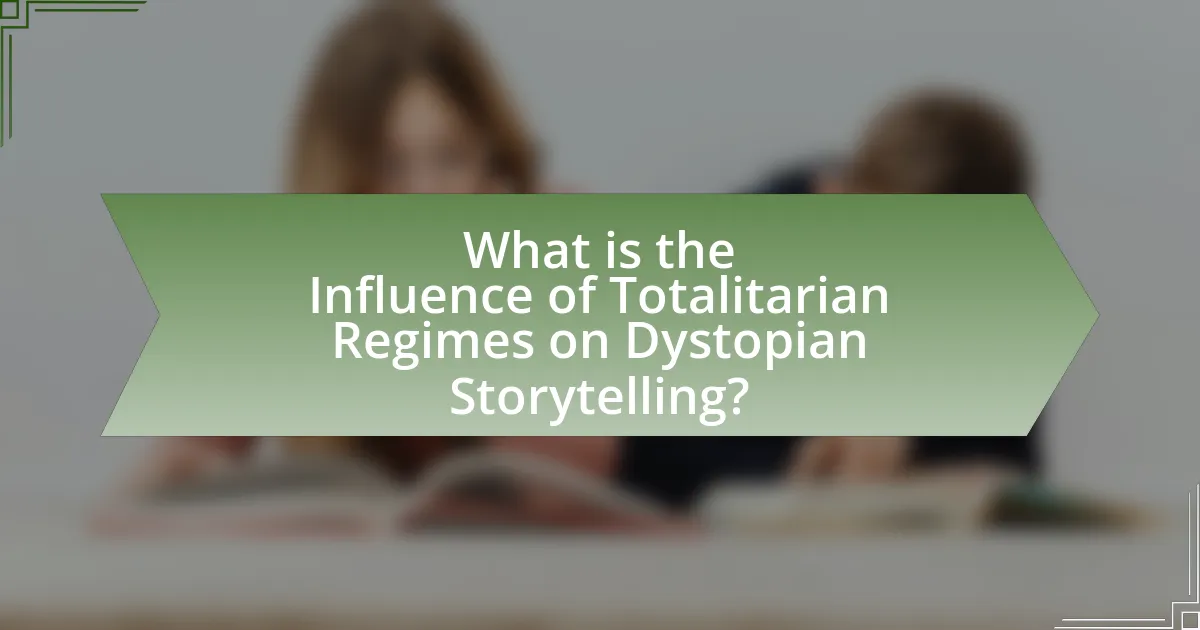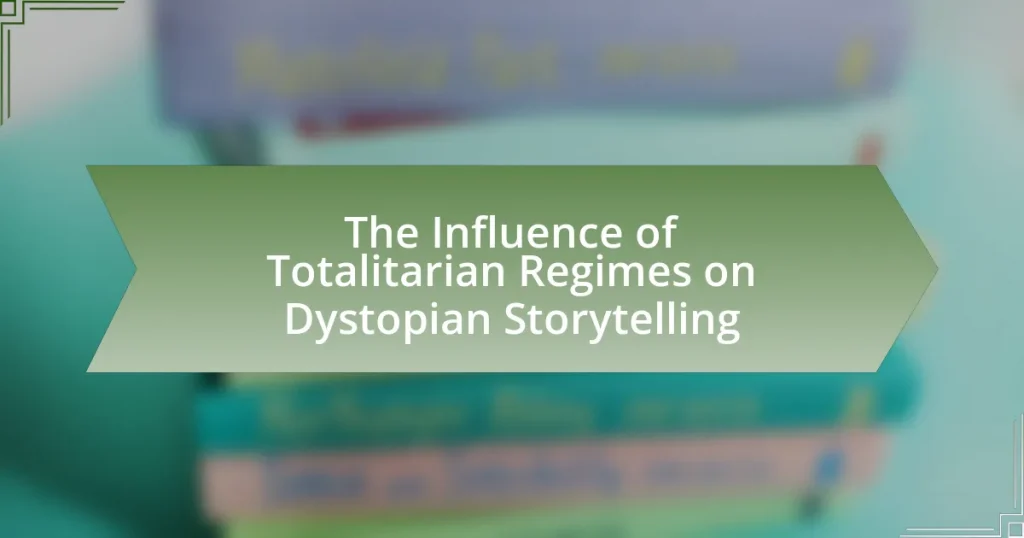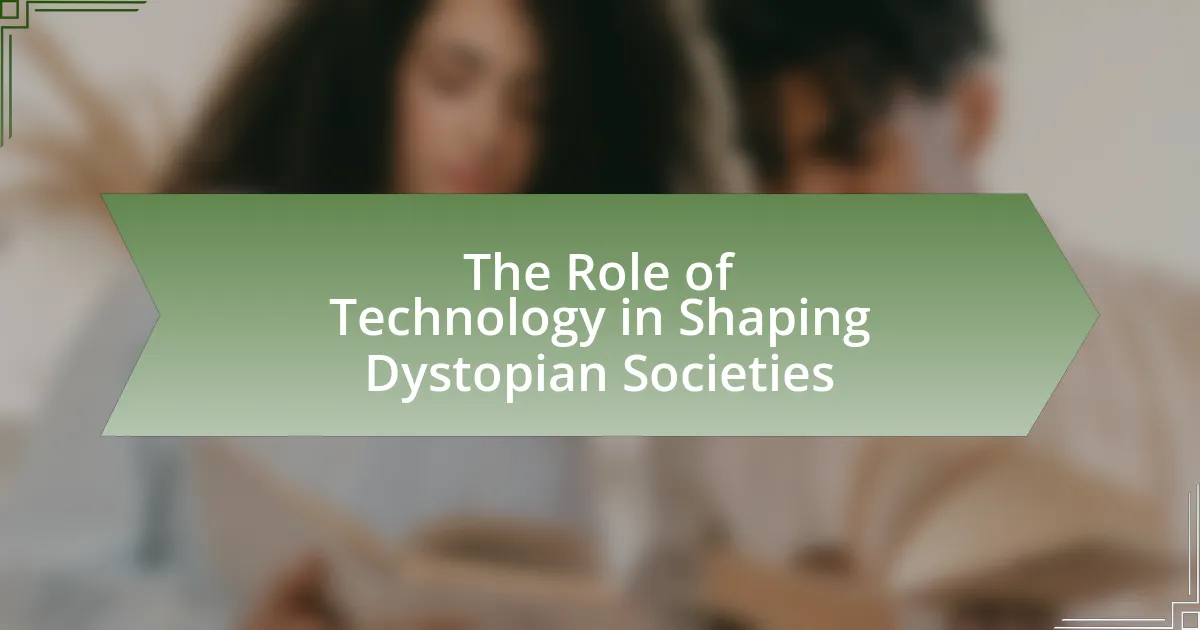The article examines the influence of totalitarian regimes on dystopian storytelling, highlighting how these oppressive governments serve as a framework for exploring themes such as oppression, surveillance, and loss of individuality. It discusses notable works like George Orwell’s “1984” and Aldous Huxley’s “Brave New World,” illustrating how these narratives reflect real-world abuses of authority and the psychological impact of authoritarianism. The article also analyzes common themes in dystopian literature, the role of characters, and narrative techniques that enhance the critique of totalitarianism, providing insights into the relevance of these stories in contemporary society and the lessons they impart about governance and individual freedoms.

What is the Influence of Totalitarian Regimes on Dystopian Storytelling?
Totalitarian regimes significantly influence dystopian storytelling by providing a framework for exploring themes of oppression, surveillance, and loss of individuality. These regimes, characterized by absolute power and control over citizens, serve as cautionary tales in literature, reflecting real-world abuses of authority. For instance, George Orwell’s “1984” illustrates the extreme consequences of totalitarianism through its depiction of a society under constant surveillance and manipulation, mirroring the oppressive tactics used by regimes such as Stalin’s Soviet Union. Similarly, Aldous Huxley’s “Brave New World” critiques the use of technology and conditioning to maintain control, paralleling the methods employed by totalitarian states to suppress dissent and enforce conformity. These narratives resonate with readers by highlighting the dangers of unchecked power and the fragility of freedom, making totalitarian regimes a central influence in the genre of dystopian storytelling.
How do totalitarian regimes shape the themes in dystopian narratives?
Totalitarian regimes shape the themes in dystopian narratives by illustrating the extreme consequences of oppressive governance and the loss of individual freedoms. These narratives often depict a society where the state exerts total control over personal lives, reflecting real-world examples such as Stalin’s Soviet Union or Nazi Germany, where censorship, surveillance, and propaganda were prevalent. The portrayal of a dehumanized populace, as seen in George Orwell’s “1984,” emphasizes the dangers of authoritarianism and the suppression of dissent. Additionally, themes of resistance and the struggle for autonomy emerge, highlighting the human spirit’s resilience against oppressive forces, which serves as a cautionary tale about the potential for totalitarianism to arise in any society.
What common themes emerge in dystopian stories influenced by totalitarianism?
Common themes in dystopian stories influenced by totalitarianism include oppression, surveillance, loss of individuality, and propaganda. These narratives often depict societies where the government exerts extreme control over citizens, leading to a pervasive atmosphere of fear and conformity. For instance, George Orwell’s “1984” illustrates the theme of surveillance through the omnipresent figure of Big Brother, symbolizing the loss of privacy and autonomy. Additionally, the use of propaganda is evident in works like Aldous Huxley’s “Brave New World,” where the state manipulates information to maintain social order and suppress dissent. These themes reflect the real-world implications of totalitarian regimes, such as the Soviet Union under Stalin, where similar tactics were employed to control the populace and eliminate opposition.
How do these themes reflect the realities of life under totalitarian regimes?
Themes in dystopian storytelling, such as surveillance, oppression, and propaganda, reflect the harsh realities of life under totalitarian regimes by illustrating the mechanisms of control and dehumanization employed by such governments. For instance, George Orwell’s “1984” depicts a society where constant surveillance by the Party exemplifies the loss of privacy and individual freedom, mirroring the practices of regimes like Stalin’s Soviet Union, where the KGB monitored citizens extensively. Additionally, the theme of propaganda in works like Aldous Huxley’s “Brave New World” highlights how totalitarian states manipulate information to maintain power, akin to the use of state-controlled media in North Korea to shape public perception and suppress dissent. These narratives serve as cautionary tales, emphasizing the dangers of unchecked authority and the erosion of personal liberties in oppressive political environments.
Why are totalitarian regimes often depicted in dystopian literature?
Totalitarian regimes are often depicted in dystopian literature because they embody extreme forms of oppression and control, serving as cautionary symbols of the potential consequences of unchecked governmental power. These regimes, characterized by authoritarian rule, censorship, and the suppression of individual freedoms, create a fertile ground for exploring themes of surveillance, conformity, and resistance. Notable examples include George Orwell’s “1984,” which illustrates the pervasive surveillance and manipulation of truth by a totalitarian state, and Aldous Huxley’s “Brave New World,” which critiques the loss of individuality in a society governed by oppressive societal norms. Such narratives reflect real historical instances, such as the totalitarian regimes of the 20th century, including Stalin’s Soviet Union and Nazi Germany, highlighting the dangers of absolute power and the erosion of personal liberties.
What historical examples illustrate this depiction?
Historical examples that illustrate the influence of totalitarian regimes on dystopian storytelling include George Orwell’s “1984,” which reflects the oppressive surveillance and propaganda of Stalinist Russia, and Aldous Huxley’s “Brave New World,” which critiques the consumerism and social control reminiscent of fascist regimes. These works serve as cautionary tales, drawing direct parallels to the mechanisms of control employed by totalitarian governments, such as censorship, manipulation of truth, and the suppression of individuality.
How do authors use totalitarianism to critique contemporary society?
Authors use totalitarianism as a lens to critique contemporary society by illustrating the dangers of oppressive governance and the erosion of individual freedoms. Through dystopian narratives, such as George Orwell’s “1984,” they depict the consequences of surveillance, propaganda, and state control, reflecting real-world issues like government overreach and loss of civil liberties. These works serve as cautionary tales, warning readers about the potential for authoritarianism in their own societies, as evidenced by historical examples like the rise of fascism and communism in the 20th century, which led to widespread human rights abuses.

What are the key characteristics of dystopian storytelling influenced by totalitarian regimes?
Key characteristics of dystopian storytelling influenced by totalitarian regimes include oppressive government control, surveillance, propaganda, and the suppression of individuality. These narratives often depict a society where the state exerts absolute power over its citizens, leading to a loss of personal freedoms and autonomy. For instance, George Orwell’s “1984” illustrates a regime that employs constant surveillance and manipulation of truth to maintain control, reflecting the tactics used by totalitarian governments such as Stalin’s Soviet Union. Additionally, themes of fear and conformity are prevalent, as characters navigate a world where dissent is punished, mirroring real historical examples like Nazi Germany. These elements serve to critique authoritarianism and highlight the dangers of unchecked power.
How do characters in these stories represent the impact of totalitarianism?
Characters in these stories often embody the oppressive nature of totalitarianism through their experiences and transformations. For instance, in George Orwell’s “1984,” Winston Smith’s struggle against the Party illustrates the psychological manipulation and loss of individuality inherent in totalitarian regimes. His eventual submission to Big Brother exemplifies the crushing power of state control over personal freedom. Similarly, in Aldous Huxley’s “Brave New World,” characters like Bernard Marx and John the Savage highlight the dehumanization and societal conformity enforced by a totalitarian state that prioritizes stability over individuality. Their conflicts reveal the detrimental effects of a society that suppresses dissent and enforces uniformity, showcasing the broader implications of totalitarianism on human identity and relationships.
What roles do protagonists and antagonists play in these narratives?
Protagonists in narratives influenced by totalitarian regimes typically represent the struggle for individuality, freedom, and resistance against oppressive systems, while antagonists embody the authoritarian forces that seek to control and suppress dissent. Protagonists often undergo significant character development as they confront moral dilemmas and societal constraints, illustrating the human spirit’s resilience. In contrast, antagonists are often depicted as embodiments of the regime’s ideology, showcasing the mechanisms of power and control, such as surveillance and propaganda. This dynamic creates a tension that drives the narrative forward, highlighting the conflict between personal autonomy and systemic oppression, as seen in works like George Orwell’s “1984,” where Winston Smith’s rebellion against Big Brother exemplifies the protagonist’s fight against totalitarianism, while Big Brother represents the ultimate antagonist.
How do character arcs reflect the struggle against oppressive systems?
Character arcs reflect the struggle against oppressive systems by illustrating the transformation of individuals as they confront and resist authoritarian forces. In dystopian narratives, characters often begin in a state of compliance or ignorance, representing the societal norms imposed by totalitarian regimes. As the story progresses, these characters typically undergo significant development, challenging the status quo and ultimately seeking liberation or justice. For example, in George Orwell’s “1984,” Winston Smith’s journey from a submissive party member to a rebellious thinker exemplifies the internal conflict faced by individuals under oppressive rule. His eventual realization of the regime’s manipulation highlights the psychological struggle against dehumanization. This transformation serves as a microcosm of the broader societal resistance, emphasizing the importance of personal agency in the fight against systemic oppression.
What narrative techniques are commonly used in dystopian storytelling?
Dystopian storytelling commonly employs narrative techniques such as unreliable narration, world-building, and social commentary. Unreliable narration creates doubt about the protagonist’s perspective, often reflecting the manipulation of truth by totalitarian regimes, as seen in works like George Orwell’s “1984.” World-building establishes a detailed and oppressive environment that highlights the consequences of authoritarian control, effectively immersing readers in the bleak realities of the society depicted. Social commentary critiques contemporary issues, using the dystopian setting to mirror and amplify real-world concerns about power, surveillance, and individual freedom, as illustrated in Aldous Huxley’s “Brave New World.” These techniques collectively enhance the thematic depth and emotional impact of dystopian narratives.
How does the use of unreliable narrators enhance the themes of totalitarianism?
The use of unreliable narrators enhances the themes of totalitarianism by creating a distorted perception of reality that reflects the oppressive nature of such regimes. In totalitarian societies, the truth is often manipulated, and unreliable narrators embody this manipulation by presenting biased or incomplete information, which mirrors the propaganda and censorship prevalent in these systems. For example, in George Orwell’s “1984,” the protagonist Winston Smith’s perspective is skewed by the Party’s control over information, illustrating how totalitarianism distorts individual understanding and truth. This narrative technique deepens the reader’s engagement with the themes of surveillance, control, and the fragility of truth under oppressive governance.
What role does world-building play in establishing a totalitarian setting?
World-building is crucial in establishing a totalitarian setting as it creates a detailed and immersive environment that reflects the oppressive nature of such regimes. This environment often includes elements like surveillance, propaganda, and strict societal hierarchies, which serve to reinforce the control exerted by the totalitarian government. For instance, in George Orwell’s “1984,” the pervasive presence of Big Brother and the concept of Newspeak illustrate how language and constant monitoring shape the citizens’ reality, effectively demonstrating the regime’s power over individual thought and behavior. Such world-building not only enhances the narrative but also provides readers with a tangible understanding of the mechanisms of control and the psychological impact on individuals living under totalitarian rule.

How do different authors approach the theme of totalitarianism in their dystopian works?
Different authors approach the theme of totalitarianism in their dystopian works by illustrating the oppressive mechanisms and societal consequences of authoritarian regimes. George Orwell, in “1984,” depicts a society under constant surveillance and manipulation of truth, showcasing how language and thought are controlled to maintain power. Aldous Huxley, in “Brave New World,” presents a more insidious form of totalitarianism through consumerism and pleasure, highlighting how societal control can be achieved without overt oppression. Margaret Atwood’s “The Handmaid’s Tale” explores the intersection of religion and totalitarianism, emphasizing the subjugation of women and the use of state-sanctioned violence to enforce conformity. These authors provide critical insights into the dangers of totalitarianism by illustrating its various forms and the impact on individual freedoms and societal structures.
What are some notable examples of dystopian literature influenced by totalitarian regimes?
Notable examples of dystopian literature influenced by totalitarian regimes include George Orwell’s “1984,” Aldous Huxley’s “Brave New World,” and Ray Bradbury’s “Fahrenheit 451.” “1984” depicts a totalitarian state characterized by pervasive surveillance and oppressive control, reflecting the realities of Stalinist Russia. “Brave New World” explores a society governed by consumerism and state control, drawing parallels to the authoritarian aspects of both fascism and communism. “Fahrenheit 451” critiques censorship and the suppression of dissent, resonating with the tactics employed by totalitarian governments to maintain power. These works illustrate the profound impact of totalitarian ideologies on the genre of dystopian literature.
How do these works differ in their portrayal of totalitarianism?
The works differ in their portrayal of totalitarianism by emphasizing distinct mechanisms of control and societal impact. For instance, George Orwell’s “1984” illustrates a regime that employs pervasive surveillance and psychological manipulation to maintain power, showcasing the extreme consequences of state control over individual thought. In contrast, Aldous Huxley’s “Brave New World” presents a totalitarian society that relies on technological advancements and consumerism to suppress dissent, highlighting the role of pleasure and distraction in maintaining social order. These differences underscore varying interpretations of how totalitarianism can manifest, either through oppressive surveillance or through the seduction of comfort and conformity.
What messages do these authors convey through their narratives?
Authors of dystopian narratives influenced by totalitarian regimes convey messages about the dangers of oppressive government control, the loss of individual freedoms, and the consequences of unchecked power. For instance, George Orwell’s “1984” illustrates the extreme surveillance and manipulation of truth by a totalitarian state, warning readers about the potential for authoritarianism to strip away personal liberties. Similarly, Aldous Huxley’s “Brave New World” critiques the use of technology and conditioning to suppress individuality and promote conformity, highlighting the risks of sacrificing freedom for societal stability. These narratives serve as cautionary tales, emphasizing the importance of vigilance against authoritarianism and the preservation of human rights.
How has the portrayal of totalitarian regimes in dystopian storytelling evolved over time?
The portrayal of totalitarian regimes in dystopian storytelling has evolved from early representations of overt oppression to more nuanced explorations of psychological control and societal complicity. Initially, works like George Orwell’s “1984” and Aldous Huxley’s “Brave New World” depicted totalitarianism as a direct and brutal force, emphasizing surveillance and state control. Over time, narratives have shifted to illustrate how totalitarianism can manifest through subtler means, such as manipulation of truth and social conformity, as seen in contemporary works like Margaret Atwood’s “The Handmaid’s Tale.” This evolution reflects changing societal concerns, particularly in response to real-world events such as the rise of authoritarianism and the impact of technology on personal freedoms.
What historical events have influenced changes in this portrayal?
The portrayal of dystopian storytelling has been significantly influenced by historical events such as the rise of totalitarian regimes in the 20th century, particularly Nazi Germany and Stalinist Soviet Union. These regimes implemented oppressive policies that suppressed individual freedoms and promoted state control, which inspired authors like George Orwell and Aldous Huxley to explore themes of surveillance, censorship, and authoritarianism in their works. For instance, Orwell’s “1984” reflects the pervasive surveillance and propaganda tactics used by totalitarian states, while Huxley’s “Brave New World” critiques the use of technology and conditioning to maintain social order. These historical contexts provide a foundation for understanding the evolution of dystopian narratives as responses to real-world authoritarian practices.
How do contemporary dystopian stories reflect current global political climates?
Contemporary dystopian stories reflect current global political climates by illustrating the fears and anxieties surrounding authoritarianism, surveillance, and social inequality. For instance, narratives like “The Handmaid’s Tale” and “1984” resonate with audiences today as they depict oppressive regimes that manipulate truth and control citizens, mirroring real-world concerns about government overreach and the erosion of civil liberties. The rise of populism and authoritarian leaders globally has led to increased scrutiny of democratic institutions, which is often mirrored in dystopian literature that critiques the fragility of freedom and the consequences of unchecked power. These stories serve as cautionary tales, highlighting the potential consequences of societal complacency in the face of rising totalitarianism, thereby reinforcing the relevance of their themes in today’s political discourse.
What practical insights can be drawn from the influence of totalitarian regimes on dystopian storytelling?
Totalitarian regimes significantly shape dystopian storytelling by illustrating the dangers of absolute power and the erosion of individual freedoms. These narratives often depict oppressive governments that manipulate truth, surveil citizens, and suppress dissent, reflecting real historical examples such as Stalin’s Soviet Union and Nazi Germany. For instance, George Orwell’s “1984” serves as a critique of totalitarianism, showcasing how language and thought are controlled to maintain power. Such stories provide practical insights into the importance of vigilance against authoritarianism, the value of free expression, and the need for societal resilience against oppressive forces.
How can writers effectively incorporate themes of totalitarianism in their narratives?
Writers can effectively incorporate themes of totalitarianism in their narratives by depicting oppressive government control, surveillance, and the suppression of individual freedoms. For instance, George Orwell’s “1984” illustrates a society under constant surveillance, where the government manipulates truth and restricts personal liberties, showcasing the psychological impact of totalitarian rule. Additionally, writers can use character experiences to highlight the loss of autonomy and the moral dilemmas faced by individuals in such regimes, as seen in Margaret Atwood’s “The Handmaid’s Tale,” where the protagonist navigates a society that enforces strict societal roles and controls reproductive rights. By integrating these elements, writers can create compelling narratives that reflect the realities of totalitarianism and provoke critical thought about freedom and authority.
What lessons can readers learn from these dystopian stories about real-world governance?
Readers can learn that dystopian stories often illustrate the dangers of totalitarian governance, emphasizing the loss of individual freedoms and the consequences of unchecked power. These narratives frequently depict how authoritarian regimes manipulate information, suppress dissent, and create a culture of fear, which serves as a warning against complacency in democratic societies. For instance, George Orwell’s “1984” showcases the extreme measures a government can take to control thought and behavior, highlighting the importance of vigilance in protecting civil liberties. Such stories encourage readers to critically evaluate their own political systems and recognize the signs of potential authoritarianism.




